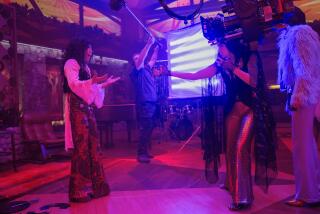Book review: ‘A Discovery of Witches’ by Deborah Harkness
- Share via
There’s something inspiring — for old-fashioned booklovers — about an early scene in Deborah Harkness’ novel “A Discovery of Witches.” Magical creatures gather as a woman opens a legendary, lost book.
Never mind that most of these creatures — vampires, daemons, witches — are plotting to get the book out of the hands of Diana, an American professor on a research trip in England. Menace aside, the scene is almost a homage to the printed word: There’s far more magic in an old book than in an iPad no matter how good its backlighting is.
“My fingers trembled when I loosened the small brass clasps…,” Diana says. “The manuscript let out a soft sigh.”
Diana isn’t just a gifted scholar of the arcane — she’s a descendant of the Bishops, a powerful family of witches. Their power flows through her effortlessly — all it takes, she says, is “a flick of my wrist and a word to the wind” — but she’s trying to live as ordinary humans do. She’s on a magic diet.
But Diana can’t help it when this old alchemical text, known as Ashmole 782, responds to her touch. A spell that has been protecting it — from whom? — suddenly weakens, and strange beings cluster like greedy wolves smelling spilled blood.
“A Discovery of Witches” — like another recent Viking title, last year’s “Angelology” — is a debut novel with a big supernatural canvas and a decidedly feminine point of view. Rather than fix on a ghostly secret in some out of the way place, its ambitions are world-sized, ranging across history and zeroing in on DNA, human and otherwordly. Age-old tensions between science and magic and between evolution and alchemy erupt as Diana seeks to unlock the secrets of Ashmole 782.
In her search, Diana has unexpected company. As she examines the book, in Oxford’s venerable Bodleian Library, she realizes that she is being watched: “It was his feral combination of strength, agility, and keen intelligence that was palpable across the room. In his black trousers and soft gray sweater, with a shock of black hair swept back from his forehead and cropped close to the nape of his neck, he looked like a panther that could strike at any moment.… He smiled. It was a small, polite smile that didn’t reveal his teeth. I was intensely aware of them anyway, sitting in perfectly straight, sharp rows behind his pale lips.”
Can I just say how difficult it is for a guy to read this stuff? Why do vamps always have the look and fashion sense of a GQ model? Is there no such thing as a homely vampire?
It’s no coincidence that this 1,500-year-old vampire, named Matthew Clairmont, happens to be in the Bodleian. He’s there to follow Diana — but we don’t know, until much later, who asked him to watch over her or why.
The book’s pace is leisurely — often a little too leisurely — as Diana and Matthew circle each other, moving from suspicion to trust. Their growing relationship plays out against several unsettling murders in London and encounters with Matthew’s fierce maman and a formidable witch assassin. Two shadowy groups, the Knights of Lazarus and the Congregation, also loom: No doubt they’ll have bigger roles in the next two books of Harkness’ projected trilogy.
A professor of history at USC, Harkness creates an entertaining world in her first novel, a place in which humans, witches, daemons and vampires peacefully coexist (well, most of the time) and even practice yoga together, as Diana discovers. Sometimes her effort to evoke this world falls flat — characters give off exotic aromas like they just stepped out of a goth Bath and Body Works. At other times, there are nice variations on familiar themes. Matthew’s immortal life has made him one heck of a wine collector, and vamps have heartbeats and can sample food, although, he says, “food tastes wrong to a vampire once it’s been cooked to death.”
On the matter of a mysterious book, though, Harkness stays true to the way books have been used in other tales of gothic adventure. Ashmole 782 remains enigmatic, a symbol of knowledge as forbidden as an apple in Eden. The book shimmers under Diana’s gaze, reminding us of an old lesson about the power of books that never goes out of style. “A little book can hold a big secret,” the witch Agatha tells Diana, “one that might change the world.”
More to Read
The biggest entertainment stories
Get our big stories about Hollywood, film, television, music, arts, culture and more right in your inbox as soon as they publish.
You may occasionally receive promotional content from the Los Angeles Times.










